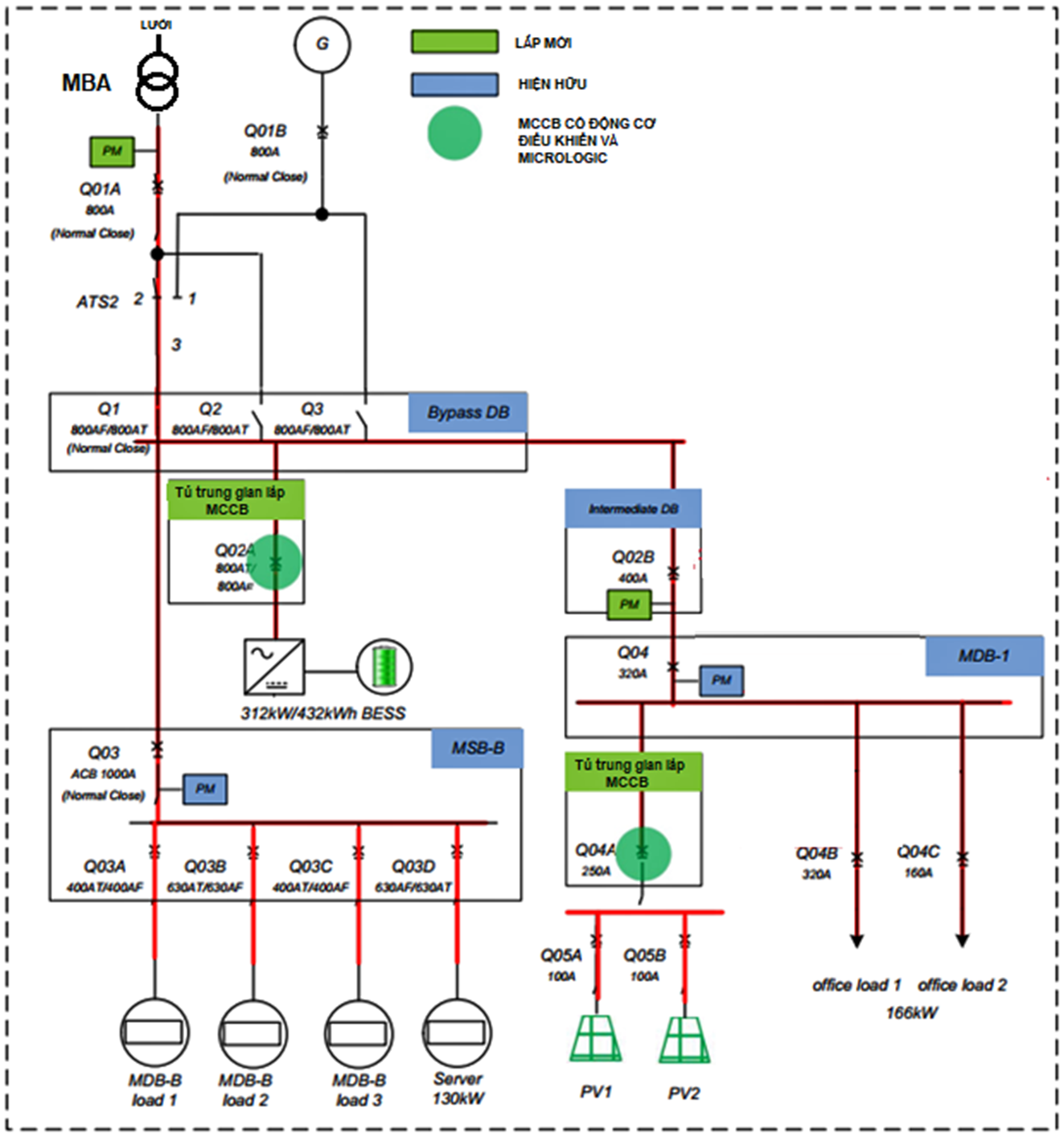Distributed energy resources and decentralized power systems play an important role in the future smart grid of Ho Chi Minh Power Corporation (EVNHCMC). Small-sized systems utilizing renewable energy and energy storage technologies with reduced greenhouse gas emissions will motivate innovation and sustainability for the smart grid. To prepare for this new trend, EVNHCMC is piloting a Microgrid project at its Data Center with integrated photovoltaic solar power (PV) and battery energy storage system (BESS). The Microgrid deploys advanced hardware and software from Schneider Electric for high stability, including the Energy Management System (EMS), Battery Management System (BES), and BESS. The study of this first grid-tied microgrid in Viet Nam will provide insights on optimizing clean and renewable energy to improve electricity quality and supply local critical loads.
The formation of EVMHCMC’s Microgrid is essentially the integration of the BESS into the existing power system of the Data Center building: a rooftop solar PV system, diesel generators, national grid connection, and electricity consumption loads. Within the Microgrid, the EMS will monitor and control BESS operations to support demand response (DR) programs, reduce grid power consumption, and inject active/reactive power when required. Additionally, the BMS provides optimized storage regimes for the BESS.
Furthermore, the Microgrid model will facilitate significant grid peak demand reduction by maintaining apt cooperation between the RTS system and the BESS. When required, the Microgrid can support load capacity regulation activities (peak shaving) of the utility and participating customers to improve power system stability. The ability to sustain Data Center loads with stable and uninterrupted internal backup power helps manage the Microgrid when incidents occur on the external grid.

Single-line diagram of the Microgrid system at the Data Center
Main components of the Microgrid:
- The main power source directly connected to the national grid, is completely dependent on the power supply quality and reliability of the local Power Company.
- A Solar power (PV) system, designed for the operational objective of maximizing energy converted from solar radiation during sunshine hours.
- A Power generation system (Genset), is designed as the backup source to restore supply for loads when the main source is interrupted. Genset response time is between 1 and 30 minutes.
- An Uninterruptible Power Source (UPS) system, designed as the backup source for a stable, uninterrupted supply at all times for critical loads. UPS system response time is between 20 and 40 milliseconds.
- The deployed BESS with installed storage capacity/rated power output of 432kWh/312kW. The selection of storage capacity/power output of the BESS is based on the following criteria:
- Ability to supply the server system operating at maximum power (228kW), which is the most critical load of the Data Center;
- Ability to maintain timely, continuous supply for all loads of the Data Center in the event of grid incidents for up to 30 minutes as the Genset is starting up;
- Ability to support peak demand reduction and demand response programs.
- A Power Conversion System (PCS), which is the BESS’s bidirectional inverter. The PCS uses a high-speed, high-capacity switch to change power sources at high speed, avoiding load supply interruption.
- A Battery Management System (BMS), which monitors and manages batteries to the level of individual cells.
- An Energy Management System (EMS) with the following basic features: (1) Peak shaving; (2) Load Shifting for Time-of-Use Savings; (3) Real and Reactive Power Injection According to User Requirement; (4) Island mode; (5) Battery Management System;
Accordingly, the deployed Microgrid model of EVNHCMC needs to meet the following operational objectives and requirements:
(1) Proactively reduce consumption of power from the grid at peak hours (in conjunction with the PV system);
(2) Contribute to demand response programs (peak shaving) when necessary (or required) to improve power system stability;
(3) Increase duration of backup supply when incidents occur on the external grid;
(4) Inject active/reactive power on demand to ensure power quality (advanced feature, depending on the quality of storage battery);
(5) Contribute to load shifting programs;
(6) Contribute to reducing PV power feeding to the grid outside of peak hours (diverted to storage battery instead of feeding to the grid);
(7) Pave the way for the research and development of grid-connected Virtual Power Plants (VPP).
The Microgrid project at EVNHCMC’s Data Center is the first grid-tied, PV, and BESS integrated microgrid in Viet Nam. It is expected to be operational in July 2022. The project is hoped to be a model for the application of advanced technology to improve power quality for on-site critical loads. As more microgrids of different sizes form in the future, they will become components and instruments to help diversify demand response programs (peak shaving, load curve flattening...), as well as contribute significantly to the development of the smart grid, transforming HCMC into a smart city.
PV
Share